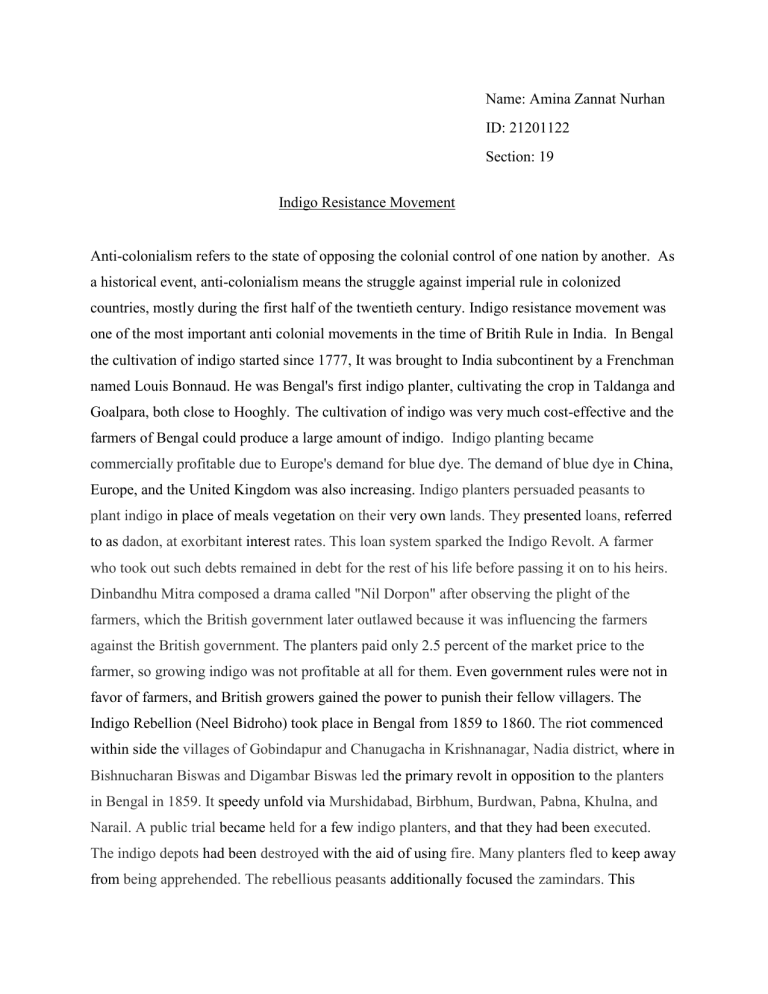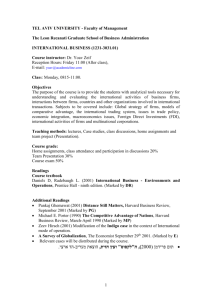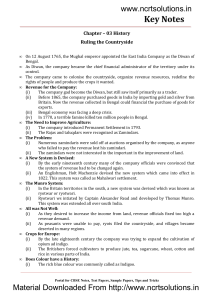
Name: Amina Zannat Nurhan ID: 21201122 Section: 19 Indigo Resistance Movement Anti-colonialism refers to the state of opposing the colonial control of one nation by another. As a historical event, anti-colonialism means the struggle against imperial rule in colonized countries, mostly during the first half of the twentieth century. Indigo resistance movement was one of the most important anti colonial movements in the time of Britih Rule in India. In Bengal the cultivation of indigo started since 1777, It was brought to India subcontinent by a Frenchman named Louis Bonnaud. He was Bengal's first indigo planter, cultivating the crop in Taldanga and Goalpara, both close to Hooghly. The cultivation of indigo was very much cost-effective and the farmers of Bengal could produce a large amount of indigo. Indigo planting became commercially profitable due to Europe's demand for blue dye. The demand of blue dye in China, Europe, and the United Kingdom was also increasing. Indigo planters persuaded peasants to plant indigo in place of meals vegetation on their very own lands. They presented loans, referred to as dadon, at exorbitant interest rates. This loan system sparked the Indigo Revolt. A farmer who took out such debts remained in debt for the rest of his life before passing it on to his heirs. Dinbandhu Mitra composed a drama called "Nil Dorpon" after observing the plight of the farmers, which the British government later outlawed because it was influencing the farmers against the British government. The planters paid only 2.5 percent of the market price to the farmer, so growing indigo was not profitable at all for them. Even government rules were not in favor of farmers, and British growers gained the power to punish their fellow villagers. The Indigo Rebellion (Neel Bidroho) took place in Bengal from 1859 to 1860. The riot commenced within side the villages of Gobindapur and Chanugacha in Krishnanagar, Nadia district, where in Bishnucharan Biswas and Digambar Biswas led the primary revolt in opposition to the planters in Bengal in 1859. It speedy unfold via Murshidabad, Birbhum, Burdwan, Pabna, Khulna, and Narail. A public trial became held for a few indigo planters, and that they had been executed. The indigo depots had been destroyed with the aid of using fire. Many planters fled to keep away from being apprehended. The rebellious peasants additionally focused the zamindars. This movement included people from all walks of life, including farmers, missionaries, Bengal academics, and Muslims. Because of the movement, the government sided with the farmers, prompting British planters to consider leaving India. As a result, by the end of 1860, Bengal's Indigo movement had been washed away, with the planters closing their factories and leaving forever. It was indeed a successful accomplishment of the suffered people. After that the government eventually announced that riots could not be forced to grow Indigo. Seeing the unity and fierce of people many zamindars also supported and helped farmers. In 1917, indigo cultivation was completely halted by Mahatma Gandhi. References: Amruta, P.A. (June 24,2022). Indigo Revolt (1859-60) - Modern India History https://prepp.in/news/e-492-indigo-revolt-1859-60-modern-india-history-notes Hossain, N.H (August 1, 2021). Indigo Resistance Movement. https://en.banglapedia.org/index.php/Indigo_Resistance_Movement Rajput, D.S. (2020, June 14). The “Blue Rebellion” and After - Ruling the Countryside. YouTube. https://youtu.be/9L21YUd77E4





